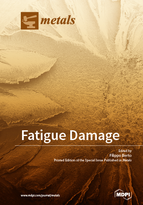Fatigue Damage
A special issue of Metals (ISSN 2075-4701).
Deadline for manuscript submissions: closed (31 January 2017) | Viewed by 89850
Special Issue Editor
Interests: fatigue and fracture behavior of materials; mechanical characterization; structural integrity of conventional and innovative materials
Special Issues, Collections and Topics in MDPI journals
Special Issue Information
Dear Colleagues,
Prevention of unexpected failures is a fundamental design objective in any engineering structure or system subjected to fatigue. Nevertheless, the complexity of modern structures and the interactivity among engineering systems, coupled with human fallibility means that failure and its consequences can only be avoided to a statistical probability. Hence, occasional catastrophic failures will occur with some of them involving the loss of human lives. Within the last few decades, a dramatic advancement has been achieved in many of the necessary technologies to either avoid or mitigate the consequences of failure. This advancement is associated with ever-increasing performance objectives for materials, structures, and machines, an increased complexity of engineered products and processes. Alongside this, catastrophic failure and its consequences are considered less tolerable in society as a whole; this ensures that efforts to prevent unexpected failures are now a cornerstone in modern engineering design and, simultaneously, a technological and scientific challenge. There is an increasing acknowledgement in the engineering community that the response to this challenge, that is, prevention of catastrophic failure, generally requires a systems approach and necessitates engagement of a large pool of multidisciplinary expertise and the deployment of tools for systems analysis. This multidisciplinary pool includes materials science, structural analysis, manufacturing technologies, quality control and evaluation, mathematics, physics, and probability and reliability. Furthermore, from the scientific point of view, there is also an increasing acknowledgement that addressing the complex engineering problems of today requires the use of concepts and approaches that can account for size and time scaling effects.
The Special Issue scope embraces interdisciplinary work aimed at understanding and deploying physics of fatigue and failure techniques, advancing experimental and theoretical failure analysis, modelling of the structural response with respect to both local and global failures, and structural design that accounts for scale and time effects in preventing engineering failures.
Prof. Filippo Berto
Guest Editor
Manuscript Submission Information
Manuscripts should be submitted online at www.mdpi.com by registering and logging in to this website. Once you are registered, click here to go to the submission form. Manuscripts can be submitted until the deadline. All submissions that pass pre-check are peer-reviewed. Accepted papers will be published continuously in the journal (as soon as accepted) and will be listed together on the special issue website. Research articles, review articles as well as short communications are invited. For planned papers, a title and short abstract (about 100 words) can be sent to the Editorial Office for announcement on this website.
Submitted manuscripts should not have been published previously, nor be under consideration for publication elsewhere (except conference proceedings papers). All manuscripts are thoroughly refereed through a single-blind peer-review process. A guide for authors and other relevant information for submission of manuscripts is available on the Instructions for Authors page. Metals is an international peer-reviewed open access monthly journal published by MDPI.
Please visit the Instructions for Authors page before submitting a manuscript. The Article Processing Charge (APC) for publication in this open access journal is 2600 CHF (Swiss Francs). Submitted papers should be well formatted and use good English. Authors may use MDPI's English editing service prior to publication or during author revisions.
Keywords
- fatigue
- crack growth
- design
- assessment






